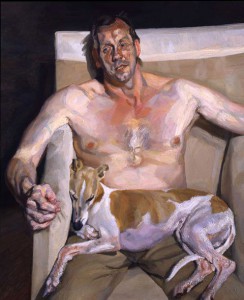 The painter Lucian Freud passed away last July at the age of 88, and, like all dead artists, interest in his work has never been higher. Today an extensive retrospective of his work opens at the National Portrait Gallery of London. The exhibition, which contains over 130 portraits spanning the entirety of his career, has generated a massive amount of buzz, both inside and outside the art industry: inside because it is the first showing of his final pictures; outside because it has already been graced by Kate Middleton, whose attendance at the royal preview yesterday marked her first solo public engagement.
The painter Lucian Freud passed away last July at the age of 88, and, like all dead artists, interest in his work has never been higher. Today an extensive retrospective of his work opens at the National Portrait Gallery of London. The exhibition, which contains over 130 portraits spanning the entirety of his career, has generated a massive amount of buzz, both inside and outside the art industry: inside because it is the first showing of his final pictures; outside because it has already been graced by Kate Middleton, whose attendance at the royal preview yesterday marked her first solo public engagement.
Freud is famous for his intensely raw portraits. His supporters, of which he has many, bandy about words like ‘honest’ and ‘unflinching’ when describing his work; his detractors, of which he also has many, throw back at them words like ‘grotesque’ and ‘cruel’. His most famous image, a 1995 portrait of an overweight woman asleep on a coach titled Benefits Supervisor Sleeping, sold for $33 million in 2008 (at the time, it was the highest price paid for a painting by a living artist), could easily be labeled all four. That’s why his work is so demonstrably good: art that caters to any concrete sense of morals or reality often fails to find its own legs, while art that doesn’t give a damn tends to live forever. Freud’s images are concerned with elaboration more than representation — that a portrait looks like the person posing for him meant very little. Freud once said, “since the picture is going to be there on its own, it is of no interest whether it is an accurate copy of the model.” Or, more succinctly: “The aura given out by a person or object is as much a part of them as their flesh.”
In 1964, American writer James Lord sat for a portrait by the artist Alberto Giacometti. The book he wrote about the experience, A Giacometti Portrait, details the process, which mostly consisted of Giacometti struggling to accurately depict what he saw. “You look like a real thug,” Giacometti told him during their first session. “If I could paint you as I see you and a policeman saw the picture he’d arrest you immediately!”
The best portraits are self-reflexive: a guest at a party with one eye on the host and the other on the door, a mirror with a carefully-placed layer of grease. One of the most famous 20th-century portraits is Picasso’s 1906 semi-abstract rendering of Gertrude Stein. When someone commented that Stein did not look like her portrait, Picasso replied, “She will.”
This post may contain affiliate links.








